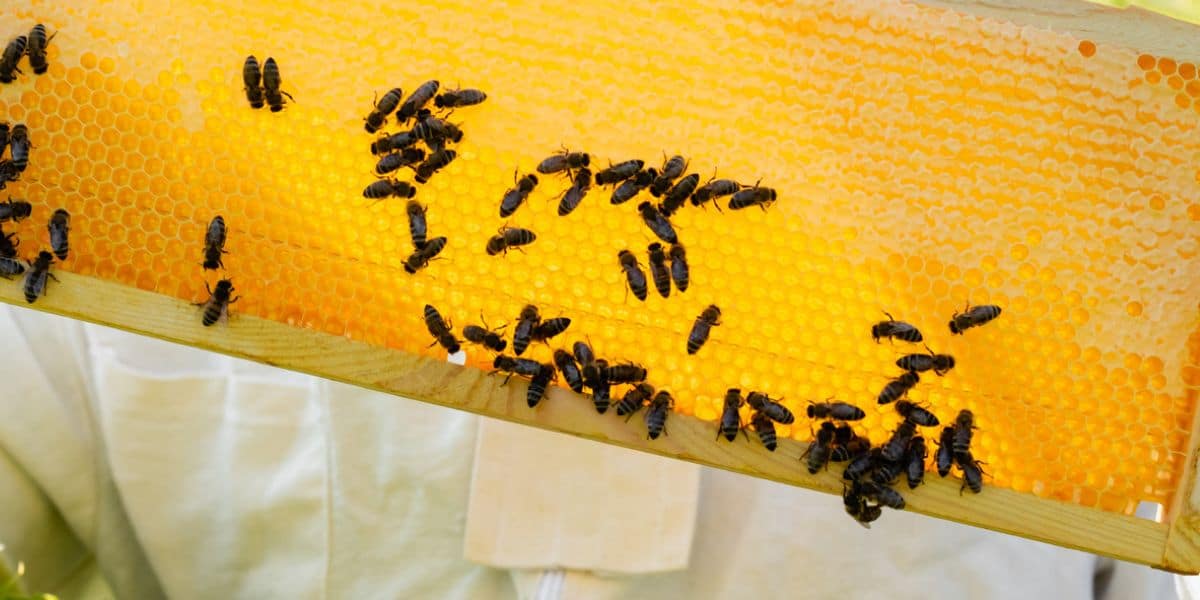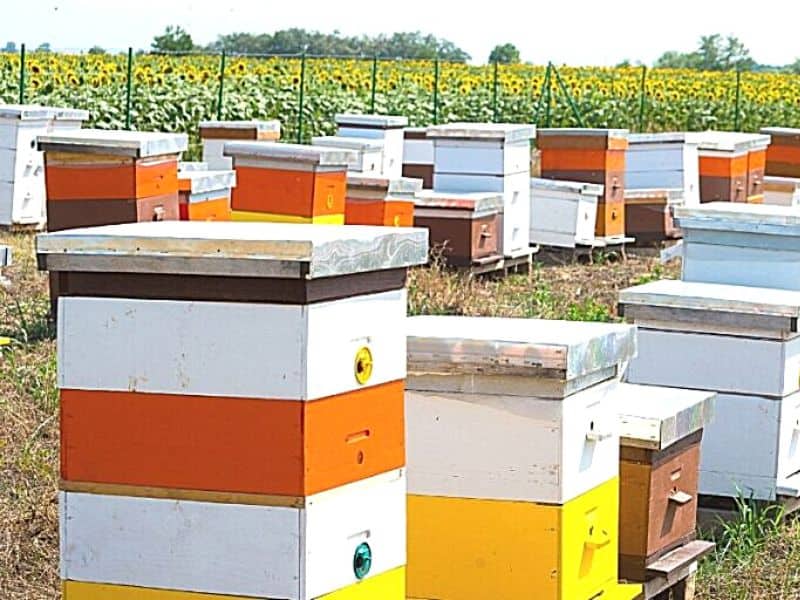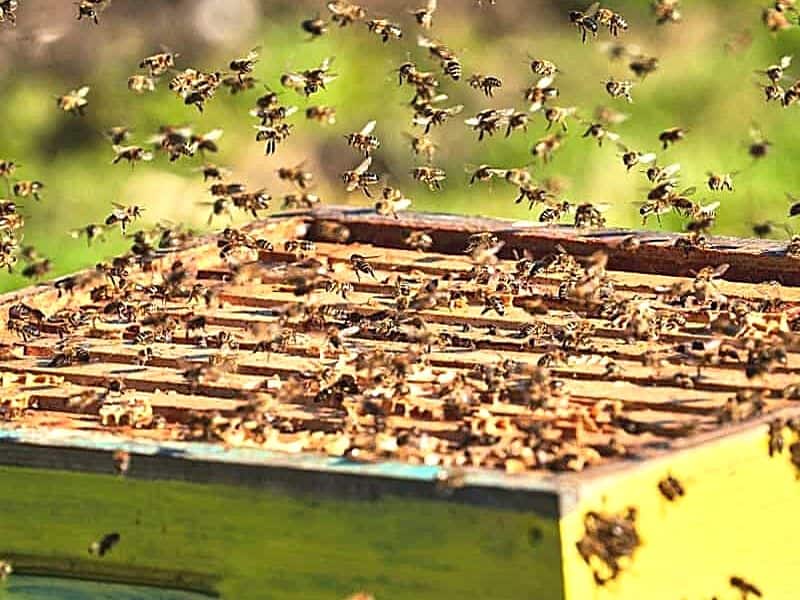How Much Honey Does a Hive Produce?
A common question asked by new beekeepers is how much honey does a hive produce. Consideration must be given to factors such as hive location, strength and more. In fact, the many variables involved in honey production-make a solid answer difficult. But, we can look at some data and get a reliable average of what to expect from a hive in the course of a season.

As a new season begins, I enjoy looking at my bee yard and imagining how many buckets I will need to hold my honey harvest. Some years it is a pleasant surprise – some… not so much.
How Much Honey Per Hive Per Year
As we consider the potential honey production for a hive during the year, some factors are completely out of our control: seasonal issues, nectar availability and even weather. All work together to give us averages at best.
Seasonal Issues
Perhaps you are under the impression that bees make honey all year. Unfortunately, that is not true in most locations.
Honey bees are insects and only fly when the daytime temperatures are warm enough. During the cold months of the year, they stay inside the hive.
A colony of bees can only collect nectar when it is available and the weather is suitable for flight. Not all plants produce nectar all season and bees can’t fly in heavy rain or high winds.
Production Estimates
So, considering how much honey one beehive can produce in a season, the best data we can hope for is an average.
A common average honey production of 60 pounds per hive is often used. This is excess or surplus that the beekeeper can collect – over the amount needed by the bees.
For those of you new to beekeeping terminology, 60# (lbs of honey) is about a 5-gallon bucket full. Pounds are used when selling honey – that’s a lot of sweetness for a family.
Some hives may produce 120 pounds in a season while others make much less or none. Your bees make not make honey this year and it may not be their fault that the honey supers are not filled. ear.

Other Honey Production Variables
In addition to the common factors (season, nectar, weather) that affect how much honey a hive produces, we have more variables that affect honey production.
- beehive location
- number of bees in the hive (colony strength)
- health of your colony – free of diseases and pests
- robbing
- hive management
Hive Location
Location of the beehive (climate) plays a large role in how much honey one hive produces. If the bees are located in an area with millions of nectar rich flowers nearby, they have plenty of resources.
By contrast, any colony with worker bees that must travel far distances to collect nectar is not able to make as much honey. Time and energy are expended on flying to the nectar source and back to the hive.
How large is your colony population? It takes thousands of workers to bring in a good harvest. A new colony – perhaps a hive split, will not have as many foragers to go out in the field.
Colony Health
What about colony health? Healthier colonies have better workers. This should be no surprise. A colony that is plagued with parasites will not be as productive as a healthy one.
That is why beekeepers must test for varroa mites routinely and treat if needed. Of course, Nosema disease and other pathogens reduce honey production too.
Robbing Issues
“Survival of the fittest” is a term used often in reference to things in nature. Strong colonies will send bees to rob weaker hives. If the bees are busy fighting off robbers, they do not have as many foraging bees out collecting nectar.
This activity can happen any time during the season but is more common during times of nectar dearth or shortage.
Poor Management
Good or poor hive management practices by the beekeeper can affect the harvest. Adding another honey super to give the colony room to work is important for maximum production.
If the bees do not have ample storage space – they may reduce collection or worse – cast a bee swarm.

Size of Your Apiary
With all the variables involved in determining how much honey one hive will produce – deciding how many hive you need for honey production is difficult.
Also, most beekeepers do not have hives of equal strength in the bee yard. Strong hives often swarm at the most inconvenient times (for the beekeeper). It is not unusual to have one colony going strong and one sitting right beside it that is not doing well.
If your apiary is overstocked with too many beehives in one location, nectar collection may suffer. But, this is normally only an issue for beekeepers with a lot of colonies (over 30 in one spot).
Why Honey Bees Make Honey
While we appreciate the wonderful gifts from the hive, bees do not make honey for us. Instead, their method of food storage is a survival technique. The hard work performed during the warm season allows them to live to the next year.

Gathering Season
Early Spring signals a time when a lot of nectar is available. Hungry colonies get to work gathering it. Some food will be used to feed – brood (developing bees) and some will be placed in storage for later use.
At the right time, beekeepers add another box or honey super (for themselves). They hope the bees will be able to fill it before the seasonal flow ends.
By June or mid July, beekeepers in some regions will be done with surplus harvest. My bees make very little honey after late June. While some areas do have a late Summer or Fall nectar flow, this is not true for all locations.
Know conditions in your region. Otherwise, you may harvest all the Spring crop and leave your colonies to starve.
I have seen this situation happen over and over again with new students that come to my online beekeeping class. Yes, they don’t understand why their hives failed last year.
Don’t over-harvest, especially if the time of the honey flow is over for your area. Feeding is a supplement but, sugar water is not honey. Bees need complete nutrition.
Winter Survival
Instead of hibernating, the honey bees survive winter inside the nest during the cold months. They may fly a bit if it is warmish outside-but they depend on stored food.
Any colony that fails to store enough food is at risk- winter beehives often die due to starvation or freezing. This would be an impossible task for a single bee. Each individual bee only makes a small amount of honey.
Honey bees instinctively make and store as much food as possible. The amount of stored honey needed by an average colony depends in part of where they live.
Hives located in the deep South can survive on 40# – while those located in the northern areas of the county will need up to 90#. A common average of 60 – 80# is the recommendation for those middle regions.
Taking Your Share
Once you know the bees are well provisioned, it is your turn. Harvest the surplus honey not needed by the bees.
Harvestable honey refers to the amount over what the bees need to keep. If there is no excess, you need to wait until next year or risk the health of your bees.
Planning for the Harvest
How many boxes of honey can you expect? The best way to get an average for honey production is to ask your local beekeeping association or agricultural department.
Be prepared for some heavy lifting. If you are a beginner beekeeper, you may be surprised at how heavy boxes of honey can be.
How much honey is in a frame? A deep frame yields about 8 pounds of honey, a medium frame about 6 pounds and a shallow slightly less.
Sometimes, the colony will not fill out all the frames in a box. You only get a partial harvest. Trying to estimate the amount of harvest you will get is useful for planning – but really only a wild guess.
Instead of trying to decide on a number of hives based on expected harvest, it is a better plan to consider how many hives you can manage – either on your own or with help.
Final Thoughts
Why do I often have two hives sitting side by side with one making 3 supers of honey and the other only 1? Assuming both are healthy, have equal populations and same management -who knows? It does seem at times that some colonies just do better than others-for no reason I can understand. Just keep in mind that all of the amounts you read about how much honey one hive produces are averages and estimates.

